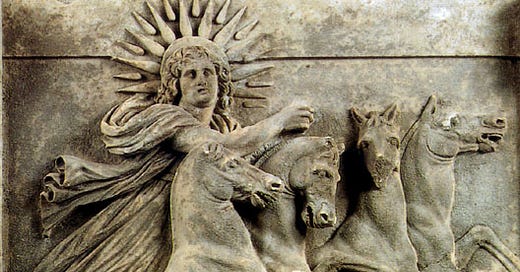Nephilim in Numbers
“There we saw the giants, the sons of Anak, descended from the giants. In our eyes, we seemed like grasshoppers, and so we were in their eyes.” Numbers 13:33
Let us turn our attention from the pre-Flood, antediluvian Nephilim to the post-Flood descendants of these Nephilim, who are still referred to with the title of “Nephilim”, but are actually like the Gibborim - simply giants with Nephilim bloodlines. Commenting on the line “the Nephilim, descendants of Anak” Daat Zkenim simply cites their powerful physical stature “anyone who took a look at these people would be overawed by them and feel totally inadequate, scared that they would attack him.”1
Commenting on the reasoning for the usage of the title “Nephilim” in this line discussing the Anakim Rashi says “Anakim who were descendants of Shemchazai and Azael who fell from heaven in the generation of Enosh [Niddah 61]. and so we were in their eyes: We heard them telling each other, “There are ants in the vineyard who look like people.” - [Sotah 35a] Anak: [The name עִנָק is given] because the sun was draped around the neck מַעֲנִיקִים because of their height. — [Sotah 34b]”2 As expected, Rashi cites the reasoning for their title being their descent from the ‘fallen angels’ Shamhazai and Azazel. He confirms their giant status by citing the Anakim as viewing us like “ants in the vineyard” with the odd reference to the “sun draped around the neck” potentially being like the appearance of the solar disk in typical sun god worship.
This point about their sun draped around their neck is important to note since it probably is a broad reference to the sun worship, stated earlier by Midrash Tanchuma as a part of their magical practice. Enosh and his generation being idolaters squares away with this understanding since the primary gods within any polytheistic pantheon are the sun gods such as Helios, or Ra, who are typically viewed with sun-disc imagery. In the case of Helios, the ‘radiate crown’ is this so-called ‘sun draped around the neck - often known in other traditions as the crown of thrones from christian imagery of Jesus after having morphed both Helios and Apollo images into those of Jesus. This can be seen clearly on the image of Helios riding his chariots where the sun ‘drapes’ all the way around his neck like a lion's mane. This was the sort of worship that Enosh was likely to have engaged with given his connection to fire. There are loads of connections that can be made between this fire worship and Zoroastrianism, as well as its later Roman worship under the Cult of Mithras, but that is a subject for an entirely different discussion.
Turning to the line prior, Numbers 13:32 we have a lengthy commentary from Ramban “The spies then continued and emphasized the strength of the giants, for at first they said, and moreover, we saw the children of Anak there, and now they exaggerated and called them nephilim; saying to the people, and there we saw the Nephilim, the three *Ahiman, Sheshai, and Talmai (Verse 22). sons of Anak who are of the ancient Nephilim about whom you have heard, for the same were the mighty men that were of old, the men of renown. And since the nature of the Nephilim who lived in the times of Noah was known throughout the world, the spies mentioned that these sons of Anak were their descendants, in order to frighten them, and to terrify them. *II Chronicles 32:18. Therefore the spies said now, and we were in our own sight as grasshoppers, and so we were in their sight.”3
Ramban supports these Anakim, named in verse 22, as descended from the Nephilim, and themselves giant in stature despite the spies report being filled with lies. Rather, the view is more that the spies reported certain facts in a way that manipulated the interpretation by the Israelites, causing them to fear the Anakim and giants of the land.
We get a commentary on verse 32 from Rashi where he connects the term ”אַנְשֵׁ֥י מִדּֽוֹת” (middot) to two other similar terms: “אִ֣ישׁ מָד֗וֹן” (middon) and “אִ֥ישׁ מִדָּ֣ה” (middah) where both of these are used in reference to Goliath. The former term being something like “man of stature” and the latter two implying “measure”. Radak continues the same thinking connecting the term ‘middah’ with ‘middot’ saying “This means great size, as in “men of middot” (Num 13:32). In the book of Samuel, though, it says “a man of madon (מדון)” (2 Sam 21:20): the nun functions in place of the doubling [of the letter], akin to the nuns in ma‘uzneha (=its strongholds; Isa 23:11) and ki lo tamnu (=have not ended; Lam 3:22). Alternatively, the nun is like the nun of zikkaron (זכרון; =reminder; Exod 17:14), and whereas the dalet should in principle have been geminated because it is not doubled, the vowel-letter compensates for this.”4
Given the multiple lines discussing Goliath's height and massive size prior to the battle with David, it’s very clear Goliath is himself part of one of these Gibborim groups, descended from the Nephilim, with this term “man of stature” being parallel to the term “mighty men” known as the Gibborim. Like the Gibborim, who are themselves giants, Goliath is also a giant who is referred to in similar parlance. Let’s discuss the Gibborim, children of the Nephilim and their possible descendant Goliath.
Daat Zkenim Bamidbar 13:33:1
Rashi Badmidbar 13:33:1-3
Ramban on Numbers 13:32:2
Radak on I Chronicles 20:6





